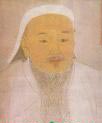| Legole.Com Discover china. Explore the beauty and wonder of the land, people, and culture of China. |
 |
|
|
 |
| |
| 1271 --- 1368 |
 During the 13th Century a great leader, Temujin, was to emerge from among the nomadic tribes of the Mongolian steppes. These tribesmen occupied the area between the northern Daxing'an Mountains and the eastern bank of the Argun River. As skilled horsemen, they were to become a formidable fighting force once the tribes had united under Temujin's leadership. In 1206 Temujin was formally elected as ruler over Greater Mongolia, encompassing the Mongolian Plateau and the Gobi Desert, and he adopted the name and title of Genghis Khan. The newly elected Khan set about extending his empire and set his sights on China. In 1227 he defeated the Western Xia and in 1234 he defeated the Jin. This was to open the way to unify the whole of China for the first time under a non-Chinese regime, a people who eventually were to become a ethnic group. During the 13th Century a great leader, Temujin, was to emerge from among the nomadic tribes of the Mongolian steppes. These tribesmen occupied the area between the northern Daxing'an Mountains and the eastern bank of the Argun River. As skilled horsemen, they were to become a formidable fighting force once the tribes had united under Temujin's leadership. In 1206 Temujin was formally elected as ruler over Greater Mongolia, encompassing the Mongolian Plateau and the Gobi Desert, and he adopted the name and title of Genghis Khan. The newly elected Khan set about extending his empire and set his sights on China. In 1227 he defeated the Western Xia and in 1234 he defeated the Jin. This was to open the way to unify the whole of China for the first time under a non-Chinese regime, a people who eventually were to become a ethnic group.
Following Genghis' death, his grandson succeeded him and as Kublai Khan, the new leader established the Yuan Dynasty in 1271, with his capital city at Dadu (present day Beijing). Kublai, who was known as Emperor Shizu continued to annex Chinese territory and in 1279 the Yuan forces captured Hangzhou, the capital city of the Southern Song (1127 -1279). The Song Emperor Gong, together with his mother the Empress Xie was taken into captivity. Three years later in 1279, the Yuan engaged in a maritime war in Yashan and crushed the "New Song" which had been formed by exiled officials and survivors from the Southern Song. With their dynasty now firmly established in the Chinese empire, the Yuan found themselves rulers of a complex group of peoples who inhabited the largest land based empire ever to exist, stretching from what is now Korea and western Russia in the north and from Burma to Iraq in the south. But they were rulers with no experience of administration. Consequently, they adopted Chinese political and cultural models.
Ruling from their capital city Dadu, the Mongol Khans increasingly adopted the role and style of Chinese emperors. However, they failed to unite the people and caused further dissension by forming them into clearly defined ethnic groups. The four classes created were firstly, the Mongols themselves, next came their allies and non-Chinese people from Inner- Asia, a class to be called the Semu. The third class was made up of the people of Northern China and they were called the Han. Lastly, came the people of Southern China, who were referred to as the Nan. The Mongols in the first group enjoyed the greatest privileges under the regime, while the fourth group, the Nan were to have the least. The same applied in so far as taxation and the penal code were concerned as this had a very divisive effect on the population as a whole. Mixed marriages were forbidden and it was impossible to gain promotion from one group to another.
During the 1340's and 1350's, internal political cohesion disintegrated due to rivalry between various factions at court, rampant corruption and a succession of natural calamities. These elements all fuelled the fires of rebellion. Mutinying workers, pirates, smugglers and rebel peasants ultimately were victorious in their fight with Mongol troops and the Yuan Dynasty was overthrown. The last Yuan Emperor together with his court fled from the country while many of the Mongols were content to remain and become integrated with the Chinese population. The man who led the final onslaught against the Yuan was Zhu Yuanzhang and he was to become the first Ming (1368 - 1644) Emperor. The Mongols were so weakened that it was not until the 15th Century that they gained sufficient strength under a leader known as Dayan Qaghan to attack the Empire's frontiers once again. The Manchu emperors of the Qing Dynasty (1644 -1911) accepted the final submission of the Mongol rulers and thus Mongolia became a part of China.
The Yuan Dynasty lasted ninety-eight years with eleven emperors. From then on, Beijing gradually ascended as the political, economic, and cultural center of China.
|
|
|
 |
|
|
 |
|
